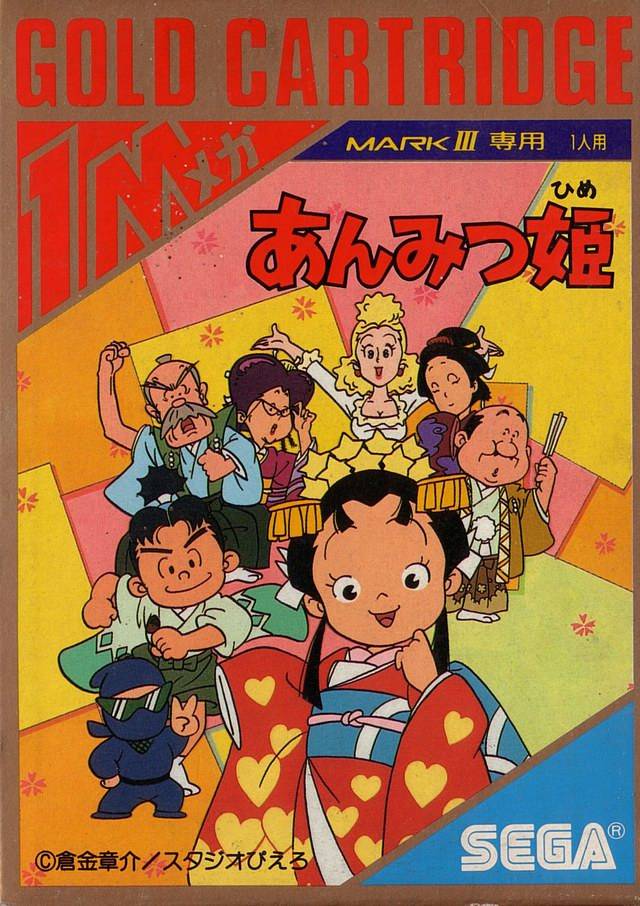
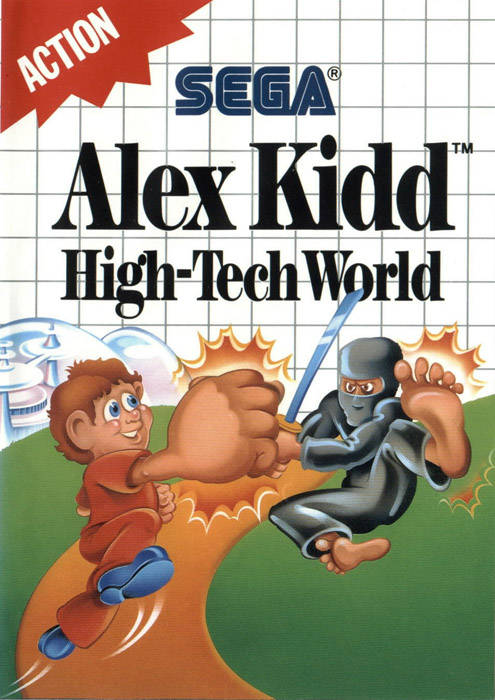
PLAYERS: 1
PUBLISHER/DEVELOPER: Sega
GENRE: Puzzle / Action
RELEASE DATE: 07/19/87 – (JP, Anmitsu Hime)
06/1989 – (US – Alex Kidd: High-Tech World)
1989 – (EU – Alex Kidd: High-Tech World)
The fate of a princess’s trip to the bakery rests squarely on your shoulders in Anmitsu Hime. Based on a popular Japanese anime from the mid-80s (which was in turn based on a manga that ran from 1949-1955), Anmitsu Hime has you guiding Princess Anmitsu through her castle, the woods, and a prefecture to get to a bakery before it closes. I could make a fair prediction as to why the princess wants to get to a bakery (ladies love their sweets, regardless of their societal standing), but in truth, I have no idea. Sega never released Anmitsu Hime outside Japan, and the game has enough hiragana to stymie the casual Japanese reader. And despite the abundance of fan-translated Japanese Master System games on the Internet, Anmitsu Hime is one of the rare few not to have a direct translation. Given this information, my experience with the game was as follows: I wandered around the castle, willed the hiragana to turn into English (it didn’t work), then turned off the game with a melancholy sigh. Anmitsu might eventually satisfy her sweet tooth at the bakery, but it won’t be because of me.
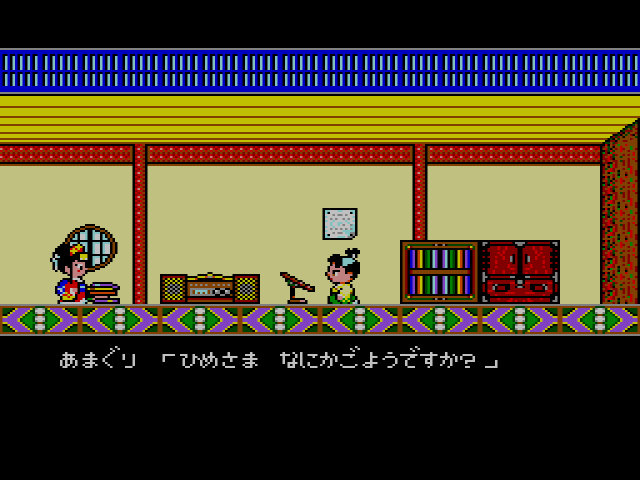
The longing of Princess Anmitsu might mean nothing to American gamers, but Alex Kidd: High-Tech World may ring a few bells. Sega turned Anmitsu Hime into High-Tech World, replacing the princess with Prince Alex. Instead of a lust for pastries, Alex has an unquenchable desire to play the latest Sega games. The game’s sprites have been changed, and the text has been altered to be more American and 1980s hip (Alex’s speech in particular indicates that he is quite a brat – not the personality I imagined from Miracle World), but the Anmitsu Hime environments – the castle, the Japanese forest, and the Japanese town – remain the same.
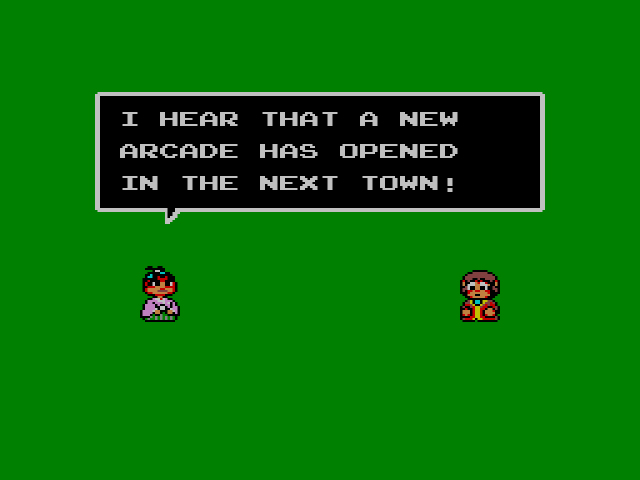
There’s nothing wrong with a company altering one of their previous games in order to adjust it for a different audience. If there was, Super Mario Bros. 2 would be an afterthought rather than the curious classic it’s become. But why Sega felt the need to make Anmitsu Hime into High-Tech World, I’m not entirely sure. After all, Alex Kidd was Sega’s big mascot before Sonic. One would expect his games to be epics, comparable to Mario’s own adventures in spirit, if not in truth. And yet, High-Tech World feels like a lapse in judgment, a short, bizarre puzzle/action hybrid that doesn’t feel like Alex Kidd should be anywhere near it.
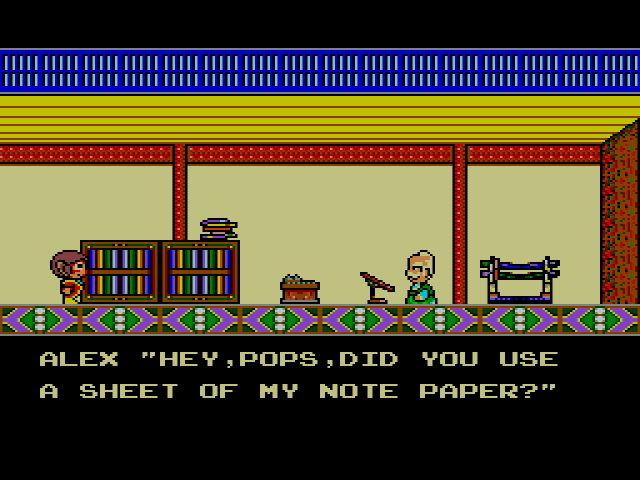
The conflict: Alex needs (not wants, needs) to get to the arcade, but there’s a first-world problem. The map to the arcade has been torn into eight different pieces and scattered throughout the five floors of his castle. To find them, you’ll explore every room and talk to Alex’s relatives and servants to see if they’ve seen them, until eventually, you recover them all.
Unfortunately, one of the game’s key problems crops its head up here: a lack of clues or direction. Many of the map pieces are, as High Tech World‘s manual states, “scattered all over the castle… in the most unlikely of places!” Ya got that right, Sega. In one room, six women sit in a row, waiting for you to give their names in the correct order. Miss one name, and not only will you not get the map scrap, but you’ll “faint,” and the game will start you from the beginning. I never found any clue in the castle as to what the women’s names were; thank goodness for FAQs.
Or how about taking the burnt scrap of paper from the old man and “fainting” because you didn’t know you were supposed to clean the paper before you grabbed it? Does Alex need a fainting servant to accompany him? What’s with this kid(d)? Good rule of thumb in the castle: if an item looks suspicious, it’s probably designed to kill you. Or it’s exactly the item you need. Seemingly mindless trial-and-error is the rule of the day here.
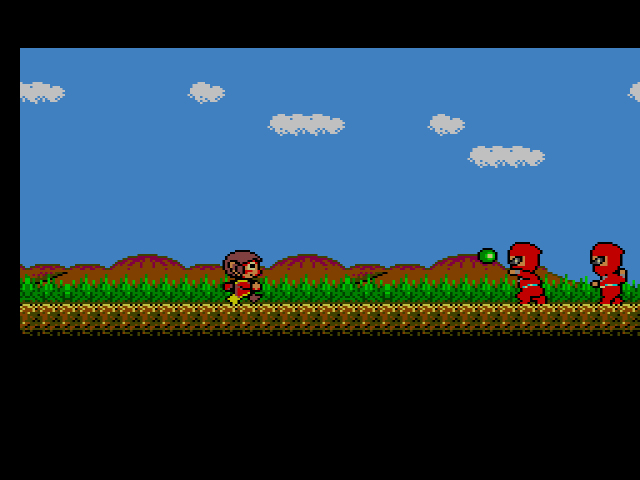
Once you find all eight pieces of the map and a Hang Glider to sail out of the castle, you’re off to the forest. Good thing about entering the forest: you get a password. Up until now, if you had a game over, you had to start from the beginning. Bad thing about the forest: it’s full of ninjas who are annoyingly precise with their throwing stars. Alex has his own stars he can counter attack with, but they can only be shot directly ahead, and the ninjas usually dwell above Alex in the trees. Other than the surprisingly agile ninjas, the forest is generic action, compared to the confusing intricacies of the castle.
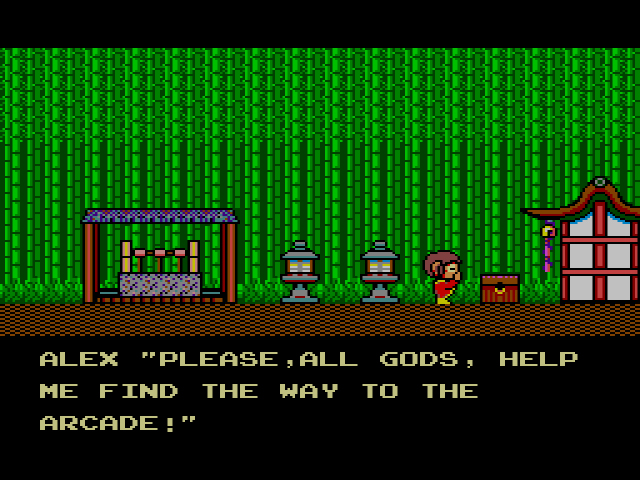
The forest spits you out into a fully-realized town, full of shops and goods and people that look nice, but don’t really matter. The town’s only real purpose is to make you pray a hundred times at the local shrine in order to progress. Once you do this, you receive a pass and can move on. Seriously. A hundred times you have to approach the shrine before you’re given a pass; monotony at its finest.
Once you leave the town, you wander through a forest area that’s a carbon copy of the first forest. Beat the second forest’s barrage of ninjas and animals, and the game’s over. Alex makes it to the arcade, spends every last drop of money he has playing OutRun, then presumably hang glides back into the castle with nobody the wiser. I’d say the abrupt nature in which Alex reaches the arcade is anti-climactic, but since there’s no real tension or purpose behind the game, him wasting his hard-earned inheritance on OutRun is a pretty appropriate ending. To paraphrase Homer Simpson, “High-Tech World is just a bunch of stuff that happens.”
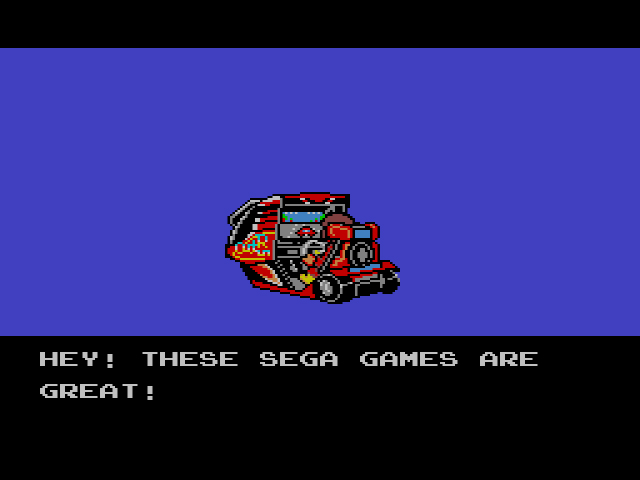
Beyond the game’s nonsensical nature, what really grabs my craw is that not one aspect of High-Tech World feels appropriate with Alex Kidd as the star – and particularly if you know that the game emerged from a different source. Put aside the confusing “puzzles,” the halfhearted action, and the purposeless town. If Sega had replaced the feudal Japan setting with Miracle World, or even Japan circa 80s so that the prospect of getting Alex to an arcade would be believable, the game would have been slightly more tolerable. As it stands, it makes no sense that Alex would be stuck in ancient Japan – both in the environments and with every character that surrounds him – and still feel like a modern character. Sega was in ultra lazy mode with High-Tech World. For a game that starred their supposed mascot/ace-in-the-hole/Mario killer, they sure weren’t treating him with much respect.
D-

15 replies on “Alex Kidd: High-Tech World (Master System, 1987)”
This was one of the last SMS I bought. As this didn’t come out in The U.S. until like summer of 89. This may be this first time you hear me argue the game should have gotten an F. This game was beyond horrible. What a waste of my hard earned money. The fury of trying to get the pass to town. There was no way whatsoever to know you had to pray 100 times at the statue. Seriously who would do that? I think I had to call SEGA. This game was a soul sucking piece of crap that I never wanted to play again. Maybe in the original game there was some story in the manga about praying 100 times at the statue or some Japanese mythology to support having that knowledge, like we know Arthur pulled the sword from the stone. But no way would an American audience know to do something like that.
I wouldn’t be surprised that praying at the statue 100 times was properly explained in Anmitsu Hime… but not here.
’89 was pretty late for an Alex Kidd game at this point. Shows how much confidence Sega had in their final product.
I will never consider this a real Alex Kidd game. Like I commented before. Miracle World, Lost Stars, and Enchanted Castle are the only real Alex Kidd games. And I hear Shinobi world is fun, never played it. I guess it was only late in American terms. The SMS had a long life in Europe and Brazil. I spring for a Genesis later that year.
I believe there are other ways besides praying 100 times to pass that part. Not that that makes the game any better.
But on the flip-side, the western boxart is almost a real boxart this time!
Sega was finally getting the box art down by the time the Genesis showed up
So basically our plucky hero’s entire motivation is to play better Sega games than his own? 😀
Couldn’t have said it better.
One of the few adventure-games that got a western release. Why did it had to be this – probably the worst – one. Seeing the succes of the classic adventure genre (Sierra, Lucas Arts) in the West, I never quite understood why not more console adventure games made it over here? A real shame, in my opinion
Though I can come up with a few possible explanations:
– Home computers were (I guess, not sure though) less popular in Japan, so a distinction between – what we consider – typical pc genres (adventures, RPG’s, tactical games, …) and console genres (arcade games, platformers, action/adventures, …) would have made no (commercial) sense over there
– Text-heavy games (this also includes rpg’s) obviously cost more to convert (translate).
On a similar note: It infuriates me, that we in Europe never saw the NES Dragon Warrior games and 2 out of the 3 SNES Final fantasy games released. I get that it woudn’t have been financially feasible to translate these games in a dozen of European Languages. But I can attest to the fact that everybody over the age of 12 in Flanders (dutch-speaking part of Belgium – I’m not as confident about the linguistic capabilities of my french speaking brethren), The Netherlands and all of the Scandinavian countries are able to understand basic english. Together with Ireland, the UK, Australia (also PAL-region I believe) and minorities in the other European countries, there would have been a sizable market … or am I wrong?
All you need is basic English to understand the early RPGs anyway. I just think game companies were smaller back then (Square certainly was), and there was no digital distribution model, so you had to be sure your game might sell enough copies to not only be worth translating, but shipping to foreign markets probably cost a bundle.
This is pure off-the-top-of-my-head speculation, though.
It’s also worth noting that SNES (for which many of the text-heavy RPGs came out in the 16-bit era) did very, very poorly almost everywhere east/south of Germany to my knowledge. Nintendo’s pricing policy kinda killed it there, Genesis was their console of choice back in the day. That is ironic, considering that pretty much everyone I know from that region owned a Famiclone (I’d assume Nintendo lost billions in the Eastern European/CIS market), and SMS is virtually non-existent. Still, to this day Nintendo is doing awful out there. Even the Switch kinda bombed in that market to my knowledge.
How many Master System Alex Kidd games are there ? I remember Shinobi World being rather good. But I’m sure there’s a God awful BMX game as well.
Thank god Sonic came along !
There were about four, I think. Wasn’t Enchanted Castle a Genesis game? I think so…
The Doki Doki Panic to Super Mario 2 translation worked so well, I think, because the original game was a solid enough platform to build and improve on. If you’ve ever played Panic, Mario 2 is definitely the better game. Plus putting the Mario characters in a “dream” world was kind of genius because then nothing really had to make any sense at all or follow the previous game in any way!
Basically, they translated the game and made it better instead of just shoving their previous characters into an older and not very good game and calling it a day.
Plus there is an argument to be made that Doki Doki panic was going to be a Mario game anyway. It was made by Shigeru Miyamoto and the Mario team. It carries similar ideas over from Mario. There is a good chance that the game was Miyamotos ideas for a Mario game that then ended up being liscenesed to a Doki Doki game. I mean it uses coins, stars, pow blocks. Adds some new things. It very much could have been a Mario game.
I quite enjoyed the castle section of this. I slogged through the rest of the game in a kind of dumbfounded fascination: the shift to action was so jarring and the execution so mediocre. I distinctly remember the sinking feeling I got when the second action section commenced – I’d really been hoping there was only one.
I finished it in an afternoon (fortunately it was a rental) without any hints, and I definitely didn’t pray 100 times, so there must have been some other way through.